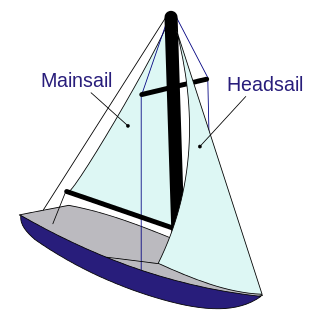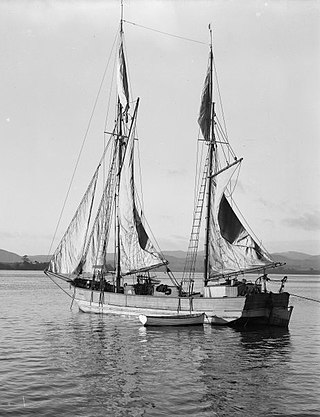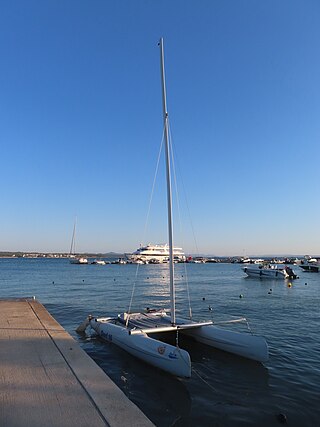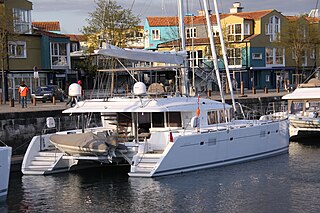The Pacific Catamaran or Pacific Cat is a sailing catamaran capable of high speeds across open water.
Contents

The Pacific Catamaran or Pacific Cat is a sailing catamaran capable of high speeds across open water.

Newport Boats and Mobjack Manufacturing began building the Pacific Cat PC-19 in 1960. It has a fiberglass hull with fractional sloop standing rigging and running rigging. This sailboat did not have a cabin but rather a well for the comfort and safety of passengers.

A sailboat or sailing boat is a boat propelled partly or entirely by sails and is smaller than a sailing ship. Distinctions in what constitutes a sailing boat and ship vary by region and maritime culture.

A scow is a smaller type of barge. Some scows are rigged as sailing scows. In the 19th and early 20th centuries, scows carried cargo in coastal waters and inland waterways, having an advantage for navigating shallow water or small harbours. Scows were in common use in the American Great Lakes and other parts of the U.S., Canada, southern England, and New Zealand. In modern times their main purpose is for recreation and racing; there are also garbage scows for aquatic transport of refuse.

A daggerboard is a retractable centreboard used by various sailing craft. While other types of centreboard may pivot to retract, a daggerboard slides in a casing. The shape of the daggerboard converts the forward motion into a windward lift, countering the leeward push of the sail. The theoretical centre of lateral resistance is on the trailing edge of the daggerboard.

Proas are various types of multi-hull outrigger sailboats of the Austronesian peoples. The terms were used for native Austronesian ships in European records during the Colonial era indiscriminately, and thus can confusingly refer to the double-ended single-outrigger boats of Oceania, the double-outrigger boats of Island Southeast Asia, and sometimes ships with no outriggers or sails at all.

Hobie Cat is a company that manufactures watercraft and other products as the Hobie Cat Company. "Hobie Cat" can also refer to specific products of the company, notably its sailing catamarans. Its fiberglass catamaran models range in nominal length between 14 feet (4.3 m) and 18 feet (5.5 m). Rotomolded catamaran models range in length between 12 feet (3.7 m) and 17 feet (5.2 m). Other sailing vessels in the Hobie Cat lineup include, monocats, dinghies, and trimarans, ranging in length between 9 feet (2.7 m) and 20 feet (6.1 m). Its largest product was the Hobie 33, 33 feet (10 m) in length. The company's non-sailing product line includes surfboards, kayaks, stand-up paddle boards, pedalboards, eyeware, and e-bikes. It was founded in 1961 by Hobart (Hobie) Alter, who originally manufactured surfboards.
Canoe sailing refers to the practice of fitting an Austronesian outrigger or Western canoe with sails.
The term beachcat is an informal name for one of the most common types of small recreational sailboats, minimalist 14 to 20 foot catamarans, almost always with a cloth "trampoline" stretched between the two hulls, typically made of fiberglass or more recently rotomolded plastic. The name comes from the fact that they are designed to be sailed directly off a sand beach, unlike most other small boats which are launched from a ramp. The average 8 foot width of the beachcat means it can also sit upright on the sand and is quite stable in this position, unlike a monohull of the same size. The Hobie 14 and Hobie 16 are two of the earliest boats of this type that achieved widespread popularity, and popularized the term as well as created the template for this type of boat.
A mast-aft rig is a sailboat sail-plan that uses a single mast set in the aft half of the hull. The mast supports fore-sails that may consist of a single jib, multiple staysails, or a crab claw sail. The mainsail is either small or completely absent. Mast-aft rigs are uncommon, but are found on a few custom, and production sailboats.

A sailing hydrofoil, hydrofoil sailboat, or hydrosail is a sailboat with wing-like foils mounted under the hull. As the craft increases its speed the hydrofoils lift the hull up and out of the water, greatly reducing wetted area, resulting in decreased drag and increased speed. A sailing hydrofoil can achieve speeds exceeding double and in some cases triple the wind speed.

The raingutter regatta is a racing event for Cub Scouts in the Boy Scouts of America that is the sailboat equivalent of the pinewood derby.

The Dart 16 is a one-design 4.80 m long sailing catamaran. It is designed to be sailed by two people. It races off a Portsmouth Yardstick of 863.

The Hobie Tiger or Hobie Tiger 18, is a French catamaran sailboat that was designed by Hobie Cat Europe as a Formula 18 racer and first built in 1995.
James Wharram was a British multihull pioneer and designer of catamarans.

The Newport to Ensenada Yacht Race is an annual 125-nautical-mile international yacht race. First run in 1948, sailors gather each spring in Newport Beach, California, to participate in one of the West Coast's premier regattas. The Newport to Ensenada yacht Race (N2E) is a race to the city of Ensenada, Baja California.
The W. D. Schock Corporation is an American boat builder originally based in Newport Beach, California, later in Corona, California and currently located in Santa Ana, California. The company was founded by William "Bill" D. Schock in 1958 and specializes in the design and manufacture of fiberglass sailboats.

The Hobie Bravo is an American catamaran sailing dinghy that was designed by Hobie Cat in 2000 and first built in 2001. The design is intended for sailing from beaches by one or two people.
Lockley Newport Boats was an American boat builder based in Newport Beach, California. The company specialized in the design and manufacture of fiberglass sailboats.
The Lagoon 37 is a French catamaran sailboat that was designed by Van Peteghem/Lauriot-Prevost as a cruiser and first built in 1991.

The Lagoon 560 is a French sailboat that was designed by Van Peteghem/Lauriot-Prevost, with the exterior design by Patrick le Quément and interior design by Nauta Design. It was intended as an offshore cruiser and also for the yacht charter role and first built in 2010.
The Lagoon 50 is a French sailboat that was designed by Van Peteghem/Lauriot-Prevost with the exterior design by Patrick le Quément and interior design by Nauta Design. It was intended as a cruiser and also for the yacht charter role and first built in 2018.
Newport Sailboats Archived 2011-07-13 at the Wayback Machine